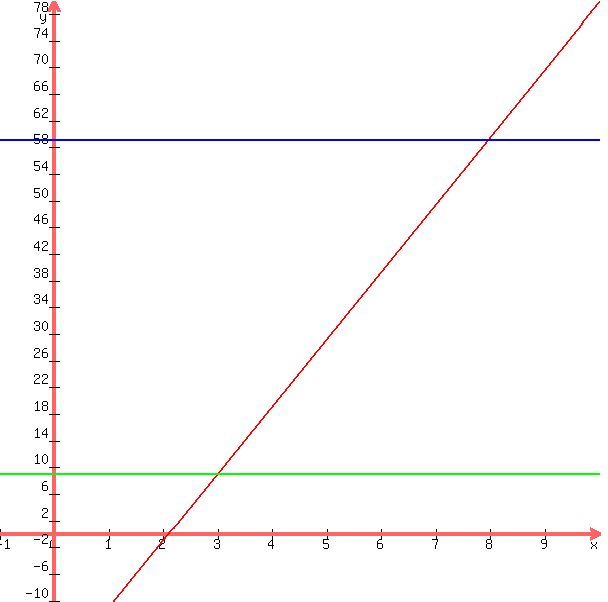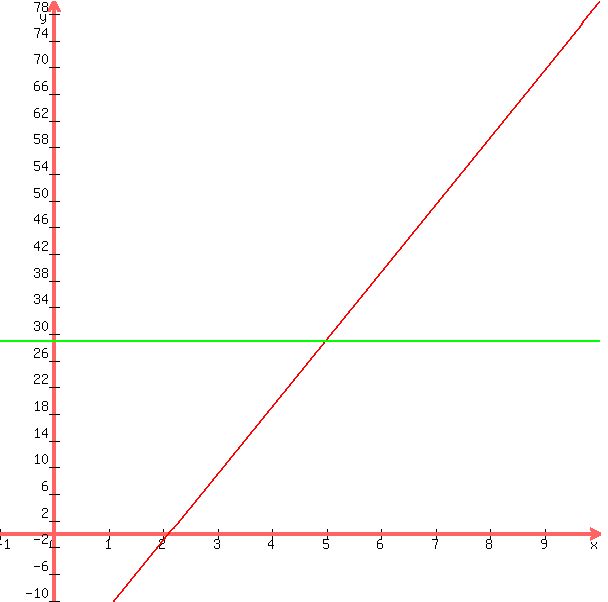Question 329629: You are building a landscape garden and want to spend no less than $3,000 and no more than $8,000. You need 35 tons of rock, each costs $60 and each tree costs $99. How many trees can you buy out of a budget of $24,000? Show your answer using inequalities.
Also want to map (6,15), what is the y-intercept.
Found 2 solutions by stanbon, Theo:
Answer by stanbon(75887)   (Show Source): (Show Source):
You can put this solution on YOUR website! You are building a landscape garden and want to spend no less than $3,000 and no more than $8,000.
You need 35 tons of rock, each costs $60 and each tree costs $99.
Show your answer using inequalities.
Also want to map (6,15), what is the y-intercept.
---
Let # of trees be "x":
3000 <= 35*60+99x <= 8000
---
900 <= 99x <= 5900
9.09 <= x <= 59.596
---
# of trees is
between 8 and 59
====================================
How many trees can you buy out of a budget of $24,000?
35*60+99x <= 24000
99x <= 21900
x <= 221 when rounded down to a whole number
---------------------
Cheers,
Stan H.
---------------------
Answer by Theo(13342)   (Show Source): (Show Source):
You can put this solution on YOUR website! x is what you want to spend.
3000 <= x <= 8000
You need 35 tons of rocks.
Each rock costs $60 and each tree costs $99.
How many trees can you buy out of a budget of $24,000?
You need 35 tons of rocks at $60 a ton.
This means that you need a total of 35 * 60 = $2100 for rocks.
If you spend $3000 on the garden, then the number of trees you can buy would be equal to $3000 - $2100 / $99 = 9.09..... which rounds out to 9 trees.
If you spend $8000 on the garden, then the number of trees you can buy would be equal to $8000 - $2100 / $99 = 59.59..... which rounds out to 59 trees.
Since you do not want to spend less than $3,000 and you do not want to spend more than $8,000 then the fact that you have a budget of $24,000 is irrelevant.
If you spend as little as $3,000, then $21,000 remains as cash available for future projects.
If you spend as much as $8,000, then $16,000 remains as cash available for future projects.
Your formula for the number of trees you can buy would be as follows:
x >= $3000
x <= $8000
budget = $24000
rocks = $60 * 35 = 2100
trees = (x - 2100) / 99 truncated to the nearest integer that is less than that value.
You can graph this as follows:

On this graph, the value of x is given in thousands.
3 = 3000
8 = 8000
The value of y is the numnber of trees you can buy.
I set y = 9 and y = 59 to show you that these values occur at around x = 3 and x = 8
This means that when x = 3000, 9 trees can be bought.
this also means that when x = 8000, 59 trees can be bought.
You can plot the number of tree you can buy in between by looking at the graph or by solving the equation for any value of x between 3000 and 8000.
The equation used to solve is:
y = (x-2100)/99 truncated to the nearest integer smaller than or equal to y.
For example:
When x = 5000, the equation becomes:
y = (5000 - 2100) / 99 = 29.29..... which truncates to 29.
Look on the graph and you will see that when y = 29, the value of x is somewhere around 5.
Here's the graph again, with the value of y = 29 shown.

In these graphs, the value of x below 3 and above 8 are irrelevant and not to be considered.
The equation for how much money is left in the budget would be:
y = $24000 - x.
In this case y would equal the money that is left in the budget.
The graph for the money that is left in the budget is shown below:

In this graph, y represents the amount of money that is left in the budget in thousands of dollars.
$24,000 equals 24 on the graph
In this graph, x represents the amount of money that is spent on the project in thousands of dollars.
$3000 = 3 on the graph
$8000 = 8 on the graph.
The only values of x that are relevant would be the values of x from 3 to 8.
You can see that when x = 3, y = 21 which means that $21,000 is left in the budget after $3000 was spent.
You can also see that when x = 8, y = 16 which means that $16,000 is left in the budget after $8000 was spent.
|
|
|